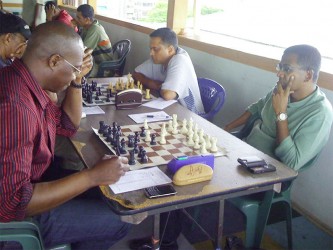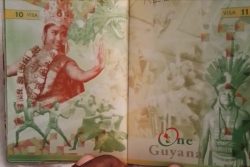For most countries, the national championship in a sporting discipline remains the celebrated feature of that particular event. In Guyana, it is no different. For instance, the National Chess Championship worldwide captures the imagination of those who play the game from the amateur to the professional levels. Winning the championship is a noble undertaking. In local chess, where the game is not contested in the numbers as it was in the 1970s and the 1980s, emerging victorious in the championship still means something of an intellectual coup, and carries with it, subdued prestige. Respect is garnered when persons are made aware of abounding enhanced intelligence coupled with attributes of perseverance, the implementation of sensible concepts and logical examples of clear thinking.
Maurice Broomes won the local national championship more times than anyone else ever did. In fact, I cannot recall a year when he failed to place first. He defeated his competition right through the seventies into the eighties. Broomes, a school teacher by profession, relieved HOE Barker of the national championship the first time that he entered the competition when Barker was the reigning English-speaking Caribbean champion. Barker never regained the championship. Since Broomes’s time, we have seen sporadic winners; one here, another one there. There ceased to be continuity in winning the championship.
 I’ve often encountered this question: How good was Maurice Broomes? I have attempted to answer, but perhaps this explanation may provide the answer. Chess ratings are used to measure the relative ability of players. The higher the rating, the stronger the player. Masters are above 2,200; international masters usually rank from about 2,400 to 2,500 and grandmasters from 2,500 on up. The highest rated players in the world are just over 2,800. World chess champion Magnus Carlsen is the highest at 2862. In 1975, when Broomes participated in the National Championship, his chess rating was 2001! Our strongest players in Guyana are yet to reach that mark.
I’ve often encountered this question: How good was Maurice Broomes? I have attempted to answer, but perhaps this explanation may provide the answer. Chess ratings are used to measure the relative ability of players. The higher the rating, the stronger the player. Masters are above 2,200; international masters usually rank from about 2,400 to 2,500 and grandmasters from 2,500 on up. The highest rated players in the world are just over 2,800. World chess champion Magnus Carlsen is the highest at 2862. In 1975, when Broomes participated in the National Championship, his chess rating was 2001! Our strongest players in Guyana are yet to reach that mark.

How good was Maurice Broomes? At the September 1975 Caribbean Championships which was hosted by President of the Guyana Chess Association Forbes Burnham, only Cuba, through its number one chess player, Emilio Estevez, was able to take a game from Maurice Broomes. He defeated, or drew, every other player from every other Caribbean nation that participated in the tournament. His only draw came from Jamaica. The Estevez game was adjourned twice, and Broomes resigned on move 89, playing Black and the Benko gambit where Black gives up a pawn for complications. Estevez held on to the pawn. I was nominated by the tournament director as the board one scribe for the host nation, so I was present throughout the Estevez game at the chessboard. On the second adjournment, Estevez said he was prepared to offer Broomes a draw based on his sealed move. The Cuban combined team had analysed throughout the night and was expecting a certain strong move which would have equalized the game for Black. Upon resumption the following morning, when the sealed envelope was opened with the waiting move, Broomes had played a different, weaker, move. As soon as Estevez posted his response, Broomes resigned immediately without further continuation. Broomes and a team of Guyanese players had analysed the position also.
From the time then prime minister Burnham established the Guyana Chess Association in 1972, a chess tournament has been held annually to determine the winner of the National Championship, except for the years when chess was dormant.
The format for the tournament has more or less remained the same, with only slight, barely discernible changes over the years. Participation has dwindled. One of the largest turnouts for the nationals was in 1975, when the tournament was held in July on the Roof Gardens of the Hotel Tower. The Championship attracted 86 participants and Maurice Broomes won, scoring a sensational 11½ points from his 12 games, and beating North Georgetown Secondary’s Joseph Chang Soong into second place on ten points. Chang Soong was the only person to exact a draw from Broomes.
At the 1972 Nationals, when the Association was formed, there were 84 participants. With that 1975 victory, Broomes secured a second lien on the Burnham Trophy which was manufactured locally, and which rested on a plaque of agate bordered with precious stones. He won his first lien in 1974, the year in which the Trophy was first introduced. Broomes eventually clinched the Trophy outright.
At the 1975 Championships, there was also a Ladies Section which was won by St Joseph High student Cyrilene Massiah, arguably the strongest female Guyanese chess player to date.
At the prize-giving reception, Broomes received a stylish chess set with separate board and pieces from the prime minister, in addition to a radio which was presented by the Guyana Radio and Electronics Company. Sir Lionel Luckhoo presented a wrist watch to Chang Soong among other prizes which were distributed. Cash as a prize was introduced some time after the seventies. The Burnham Trophy continued to be made available following the ’75 tournament probably until Burnham passed on. (I cannot actually remember the final year when we competed for the trophy), and, until David A Granger was elected President of the Guyana Chess Federation.
An exodus of our precious chess players occurred eventually and it was not until 2006 that the engine of chess promotion got re-energized. The next year, 2007, the first National Chess Championship since the turn of the millennium was revisited. Loris Nathoo travelled to the US at his personal expense, to purchase ‘a shoulder bag of chess clocks’ as we called his magnanimous venture. You can say Nathoo electrified the re-commencement of the majestic National Championship. Without chess clocks, we cannot have chess tournaments.
Nathoo, in his never-ending quest to improve the attraction of and perhaps the attention to the rich ancient game, and in a solitary voice, has expressed a desire for the format of the National Championship to be slightly modified to obtain a more fulfilling version of appearances. Chess remains a struggling pastime. At the moment, for the National Championship, an open preliminary tournament is held. The top seven participants are chosen to meet with the previous year’s national champion in a single round robin competition. The participant who places first in the competition would be declared the national champion. Nathoo is advocating however, that a one-on-one encounter be promoted between the current national champion and his most worthy challenger, so as to generate renewed interest in the game. A reduced number of players could be chosen from the elimination preliminary tournament, say four persons—the top four finishers—and a double round robin tournament be held. The winner of that tournament would qualify to meet the previous national champion. In the meanwhile, Nathoo explained, the contest between the champion and the challenger would be highlighted through continuous press reports.
An energetic idea, I would say. Maybe the GCF may wish to consider hosting the elimination preliminary tournament during the July-August school vacation to improve attendance at the tournament. Mae’s Schools, for example, boasts a fair number of chess players.
Perhaps Nathoo’s suggestions can be discussed among the executive members of the GCF committee to earn their trust and confidence. Earning people’s trust should not be a moral issue, but rather a strategic one. In this case, the strategy is tied to the improvement of the quality and promotion of the game.
Chess games
Vishy Anand won the classical section of the Zurich Chess Challenge Tourna-ment in Switzerland. Here are three games from the tournament.
White Viswanathan Anand
Black Hi Nakamura
- d4 d5 2. c4 e6 3. Nc3 Be7 4. Nf3 Nf6 5. Bf4 O-O 6. e3 Nbd7 7. c5 Nh5 8. Bd3 Nxf4 9. exf4 b6 10. b4 a5 11. a3 c6 12. O-O Qc7 13. g3 Ba6 14. Re1 Bf6 15. Kg2 Bxd3 16. Qxd3 Rfb8 17. h4 Qa7 18. Ne2 g6 19. Rab1 axb4 20. axb4 Qa2 21. Rec1 bxc5 22. bxc5 h5 23. Ne5 Nxe5 24. fxe5 Bg7 25. Rb6 Rc8 26. Nc3 Qa7 27. Rcb1 Qd7 28. R1b4 Bh6 29. Na4 Qd8 30. Ra6 Kg7 31. Rb7 Rxa6 32. Qxa6 g5 33. Qe2 g4 34. Qa6 Qg8 35. Nb6 Rf8 36. Nd7 Qh7 37. Nxf8 Qe4+ 38. Kh2 Kxf8 39. Rb8+ Kg7 40. Qc8 Kg6 41. Qh8 1-0.
White Viswanathan Anand
Black Levon Aronian
- d4 Nf6 2. c4 g6 3. Nc3 d5 4. Nf3 Bg7 5. Qb3 dxc4 6. Qxc4 O-O 7. e4 Na6 8. Be2 c5 9. d5 e6 10. O-O exd5 11. exd5 Re8 12. Rd1 Bf5 13. d6 h6 14. Be3 Ng4 15. Bf4 Bxc3 16. bxc3 Re4 17. Qb5 Rxf4 18. Qxb7 Ra4 19. d7 Be4 20. Qb3 Bc6 21. Rd6 Bxd7 22. Rad1 Qb8 23. Rxd7 Qxb3 24. axb3 Ra2 25. Bc4 Rf8 26. R7d6 Kg7 27. Rxa6 Rxf2 28. Re1 1-0.
White Hi Nakamura
Black Sergey Karjakin
- Nf3 Nf6 2. c4 c5 3. Nc3 Nc6 4. d4 cxd4 5. Nxd4 e6 6. g3 Qb6 7. Ndb5 Ne5 8. Bf4 Nfg4 9. Qa4 g5 10. Bxe5 Qxf2+ 11. Kd1 Nxe5 12. Nc7+ Kd8 13. Nxa8 Qd4+ 14. Kc2 Nxc4 15. e4 Ne3+ 16. Kb3 Qd2 17. a3 Qc2+ 18. Ka2 Qxa4 19. Nxa4 Nxf1 20. Rhxf1 b5 21. N4b6 axb6 22. Nxb6 Bb7 23. Rxf7 Bc6 24. Rd1 Be7 25. Rf3 Kc7 26. Nxd7 Rd8 27. Rc3 1-0.








